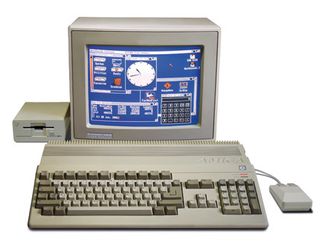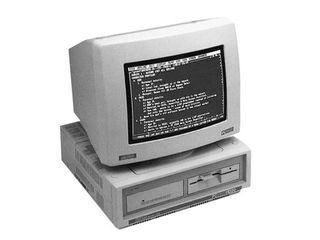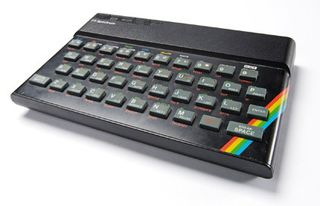5. PIC Family
You could shell out up to £850 on a processor for a desktop PC, so it might be something of an eye-opener that several members of our fifth-place PIC family of chips sell in bulk for less that 50p.
The PIC10F200 manufactured by Microchip, for example, has a volume price of just 21p! Needless to say, you're not going to get blistering performance from this chip – it's intended for so-called embedded applications, so you're likely to find it hidden away inside a clinical thermometer or a touch-sensitive light switch, rather than a PC.
It has an 8-bit architecture and is clocked at 4MHz. It boasts built-in flash memory for a 256-instruction program, and it has 16 bytes of RAM. What's more, external memory can't be added – not surprisingly, considering this is a 6-pin chip.
Powerful or not though, eight billion have sold to date. It seems that small truly is beautiful.
4. Motorola 68000
Intel was the first to introduce a mass-market 16-bit chip. Motorola came late to the market in 1979, but leap-frogged Intel by going straight to a hybrid 16/32-bit processor – the 68000. That chip powered a generation of Apple Macs, Amigas and late-model Ataris.
Get daily insight, inspiration and deals in your inbox
Get the hottest deals available in your inbox plus news, reviews, opinion, analysis and more from the TechRadar team.

AMIGA A500: The 68000 powered the hugely successful Amigas and in so doing, gained a loyal following who still reminisce fondly about it today / PHOTO: Bill Bertram
Nick Veitch, one-time editor of Amiga Format magazine, recalls: "One great thing I remember about programming the 68k was that it was easy to use the instructions in a variety of addressing modes, which made things a lot easier than the alternatives. I remember old-time hackers comparing it to the PDP (the original hacker machine at places like MIT), rather than the other microprocessors of the day like the Z80."
Whereas the x86 architecture is still going strong, the last member of the 68000 family, the 68060, was launched in 1994. It was later dropped in favour of the PowerPC family.
3. ARM family
British firm Acorn cornered the education market with their 6502-based BBC Micro, and when the world turned to 16-bit computing, it launched its successor machine, the Archimedes, to do the same for a new generation.
Acorn took a bold approach: rather than basing its new computer on established processors from Intel or Motorola, it designed its own 32-bit processor called ARM (originally standing for Acorn RISC Machine, but now Advanced RISC Machine).
By adopting the Reduced Instruction Set Computer (RISC) approach at a time when most of the other semiconductor manufacturers were employing the Complicated Instruction Set (CISC) approach (today's x86 chips employ elements of both philosophies), the ARM chip was well ahead of the competition.
Despite initially having just an 8MHz clock, the first ARM-based systems were much faster than contemporary machines with Intel 80386s or Motorola 68020s, even though the latter were clocked at twice the speed. However, while it was technically superior, the growing momentum of the PC clones proved its downfall, and the last Archimedes was launched in 1992.
That wasn't the end of the ARM processor, though – far from it.
From tiny Acorns
Acorn might be long gone, but it lives on in the form of its former subsidiary ARM Holdings. More importantly, so does its pioneering processor.

ARM POWER: 95 per cent of mobile phones worldwide, including the Nokia X6, use ARM processor cores
According to ARM, there are over 15 billion ARM-based chips in existence, powering over 95 per cent of mobile phones and over 25 per cent of all electronic devices. All this is down to that innovative RISC design, as simplicity means low power consumption.
Strangely, none of the four billion RISC cores made every year are actually manufactured by ARM. Instead, ARM licenses its intellectual property to other companies, who then incorporate it into their own designs. That means Nokia mobile phones, for example, contain Nokia-designed chips with an ARM core.
If you bought this processor for yourself, you wouldn't get a chip of silicon, but something that resembles a computer program – defining the core in a way that can be incorporated into a custom chip. You can build one, right?
2. Intel 8086
There's really no surprise in seeing this legendary chip near the top of the list, is there? The 8086 was Intel's first foray into 16-bit computing, while the 8088 was the cut-down version that made its appearance in the IBM PC, and in doing so, changed the face of personal computing forever.
The mid-70s were the heyday of processor development. The microprocessor revolution was less than seven years old when the 8086 entered the world in 1978. But then we were into the third generation after 4-bit and 8-bit designs.

AMSTRAD: The Amstrad PC1512 used the 16-bit 8086 yet still drove down the cost of personal computing
What's more, the 8086 was clocked at 5MHz, up from the 4004's 740kHz just over six and a half years earlier. But there was a much more fundamental difference. Intel's 8-bit processors did end up inside computers, but none of these early personal computers exactly flourished – the chips really hadn't been designed with domestic applications in mind.
It's widely reported, for example, that one of Intel's first successes for the 8080 was in automated ticketing equipment for metro systems. Whether Intel really expected the new 8086, and its little brother the 8088, to power computers that would compete with minicomputers costing tens of thousands of pounds is unclear – but that's exactly what they did, and they did it phenomenally well.
Price wars
Released in 1981, the first IBM PC was still considerably more expensive than the home computers of the day, and as a result, there's no doubt that it was aimed at businesses rather than consumers.
The appearance of clones changed all that, though, and prices soon started to drop. Here in the UK, Alan Sugar's Amstrad was instrumental in driving down prices when it launched. The PC1512 had an incredibly competitive £499 price when it appeared in 1986.
By including both a floppy disk drive and a monitor, it was the first affordable serious computer. Interestingly, that rough price level has stuck ever since. Whereas today we're getting thousands of times more power for our money, we still owe a lot to that original 8088-based machine.
1. Ziglog ZX80
Back in the early 80s, the UK led the world for home computer ownership. This was due in no small part to the eff orts of one company – Sinclair Research. The ZX80 was the first home computer to break the £100 barrier, and with the ZX81, the price dropped to £69.95 (or £49.95 in kit form).

ZX SPECTRUM: This piece of tech makes us get all misty-eyed
Their successor, the ZX Spectrum, gave many people their first real taste of computing and it stayed cheap. Apart from the manufacturer and attractive pricing, all these home computers had one important thing in common – their use of the Zilog Z80 processor.
Blast from the past
The Z80 competed head-on with our eighth-placed chip, the 6502, in the home computer market of the early 80s. Its origin was on the other side of the great Intel-Motorola divide, having more in common with Intel's 8080. Given that it was designed by the 8080's maker Federico Faggin, who left Intel to set up Zilog, this is hardly surprising. Oddly, it seems likely that Faggin never really envisaged the Z80 being used in anything other than embedded applications.
It flourished on domestic machines nonetheless – in addition to home computers from Sinclair, the Z80 was used in such well-known computers as the Tandy TRS-80, the Amstrad CPC and PCW, and the Sharp MZ-80. It's now 34 years since the Z80 first made its appearance and you'd be excused for assuming that the chip is long gone.
In fact, Zilog is still making waves in 2010, something that has contributed in no small part to the Z80 achieving top spot in our league table. Of course, you won't find a Z80 in any modern-day computer – the 16-bit, 32-bit and 64-bit processors have made sure of that.
However, for embedded applications, it's still going strong today, decades after many of its contemporaries have ceased production. Amazingly enough, you can still buy a Z80 lookalike that's identical to its 1976 counterpart.
Zilog's Z84C0006PEG, for example, has a 6MHz clock and is housed in a 40-pin DIP – that's the big old black plastic chip with a row of pins down each of the long edges. Other variants are clocked at higher speeds and look much more like the modern-day components you see today.
High acclaim
Slightly further removed from the original Z80 is the eZ80Acclaim! family of microcontrollers. Containing a Z80 core that's software compatible with the very first Z80, this device also includes on-chip flash memory for the program, RAM and input/output circuitry.
Some family members even have Ethernet capability. You can expect to find it hidden away in vending machines, security systems and sales terminals. So, for kick-starting the home computer revolution of the early 80s while still beavering away behind the scenes 34 years later, we take our hats off to the most influential processor ever. Here's to the next three decades…
-------------------------------------------------------------------------------------------------------
First published in PC Plus Issue 299
Liked this? Then check out Building the computer that could halt nuclear armageddon
Sign up for TechRadar's free Weird Week in Tech newsletter
Get the oddest tech stories of the week, plus the most popular news and reviews delivered straight to your inbox. Sign up at http://www.techradar.com/register
- 1
- 2
Current page: 10 most influential processors: 5-1
Prev Page 10 most influential processors: 10-6